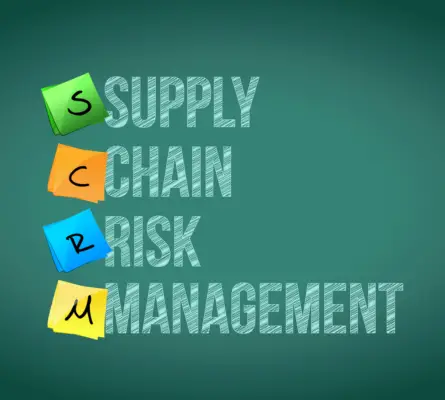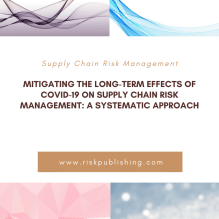This article explores the best approaches for mitigating supply chain risk management.
Supply chain risks can significantly impact the performance and profitability of organizations, making it crucial to manage and mitigate these risks effectively.
Supply chain risk management, In the aftermath of COVID-19, many businesses have been affected. The illness has caused a shortage in supply, impacting the global economy. You should systematically reduce risk and improve efficiency to mitigate these effects on your supply chain. Here are five ways that you can do so:
Conducting risk assessments and implementing appropriate strategies, organizations can minimize the negative impacts of supply chain risks.
Additionally, technology-based solutions play a vital role in enhancing supply chain risk management approaches.

Definition of Supply Chain Risks
Supply chain risks can include transportation disruptions, delivery delays, and demand fluctuations.
To effectively manage these risks, companies can implement strategies such as diversifying their supplier base, developing contingency plans, and improving communication and collaboration within the supply chain network.
Types of Supply Chain Risks
Types of supply chain risks encompass potential disruptions and vulnerabilities that can impact the smooth flow of materials, information, and finances within a supply chain network. These risks can be categorized into different types, including operational, financial, and external risks.
Operational risks refer to challenges that arise within the internal processes of the supply chain, such as production delays, quality issues, or inventory management problems.
Financial risks involve uncertainties related to financial factors, such as currency fluctuations, payment defaults, or credit risks.
External risks, on the other hand, stem from factors beyond the control of the supply chain, such as natural disasters, political instability, or changes in regulations.
To effectively manage these risks, supply chain managers can employ strategies such as developing contingency plans, fostering strong relationships with partners, embracing new technologies, and implementing robust processes to mitigate potential disruptions and ensure the resilience of the supply chain network.
Risk Assessment
Identifying potential risk events involves identifying and analyzing all possible risks in the supply chain. These risks could include natural disasters, supplier failures, or transportation disruptions.
Assessing the severity of risk events involves evaluating the potential impact of these risks on the supply chain. Factors to consider may include financial losses, customer dissatisfaction, or reputational damage.
Estimating the occurrence and duration of risk events involves determining the likelihood of these risks happening and the expected duration of their impact.
Developing a risk profile for the supply chain involves creating a comprehensive overview of the risks faced by the supply chain. This allows for effective risk mitigation strategies to be developed and implemented.
Risk assessment in supply chain management involves a systematic approach to identifying, assessing, and managing potential risks to ensure the smooth operation of the supply chain.
Identifying Potential Risk Events
One effective approach to mitigating supply chain risk is identifying potential risk events. By proactively identifying potential risk events, organizations can better prepare and develop strategies to mitigate the impact of these events on their supply chain operations.
Some key strategies for identifying potential risk events include:
- Conducting a comprehensive risk assessment: This involves analyzing all aspects of the supply chain to identify potential vulnerabilities and risks.
- Collaborating with supply chain partners: By working closely with supply chain partners, organizations can gain valuable insights and information about potential risks and develop collaborative strategies to mitigate them.
- Enhancing supply chain resilience: Building resilience into the supply chain can help organizations withstand and recover from disruptions.
- Utilizing data analytics: Leveraging data analytics can help organizations identify patterns and trends indicating potential risk events.
- Continuously monitoring and evaluating risks: Regularly monitoring and evaluating risks allows organizations to stay informed and proactively adjust their supply chain risk mitigation strategies.
Identifying potential risk events is crucial in effective supply chain risk management, enabling organizations to develop robust strategies to mitigate supply chain risks.
Assessing the Severity of Risk Events
Assessing the severity of risk events is a critical step in supply chain risk management, as it allows organizations to prioritize their response and allocate resources accordingly. By evaluating the potential risks and supply chain risk factors, organizations can determine the impact of risks on their operations and make informed decisions on risk mitigation strategies.
This involves conducting a comprehensive risk assessment and analysis to identify the severity of each risk event. To effectively assess risk severity, organizations can utilize a 3-column and 5-row table to categorize risks based on their potential impact, likelihood of occurrence, and detectability.
This table can serve as a visual aid to help management prioritize risks and develop proactive measures to mitigate their impact. Additionally, organizations can invest in comprehensive training programs and management training to ensure all stakeholders have the necessary skills and knowledge to assess and manage risks effectively.
Estimating the Occurrence and Duration of Risk Events
Estimating the occurrence and duration of risk events requires a systematic analysis of historical data, industry trends, and expert opinions to forecast the likelihood and duration of potential disruptions in the supply chain. Accurately estimating risk events is crucial for effective risk management strategies and mitigating supply chain risks.
To estimate the occurrence of risk events, historical data on past disruptions can be analyzed to identify patterns and trends. This data can help identify the likelihood of similar events occurring in the future. Additionally, industry trends and expert opinions can provide valuable insights into the potential occurrence of specific risk events.
Estimating the duration of risk events involves assessing the time required to recover from disruption and resume normal operations. This can be influenced by factors such as the complexity of the supply chain, the availability of alternative suppliers, and the effectiveness of contingency plans.
By estimating the occurrence and duration of risk events, organizations can develop effective risk mitigation strategies and implement appropriate risk management approaches.
This allows for proactive planning and the ability to respond swiftly and efficiently when disruptions occur, minimizing the impact on the supply chain and ensuring business continuity.
Developing a Risk Profile for the Supply Chain
Developing a risk profile for the supply chain involves analyzing various factors contributing to potential disruptions and identifying their potential impact on the overall supply chain operations.
This process aims to establish a comprehensive understanding of the risks faced by the supply chain and develop appropriate response and continuity approaches.
- Analyzing the supply chain components, such as suppliers, transportation, and inventory management, to identify potential risks.
- For example, assessing the vulnerability of single-source suppliers or evaluating the impact of transportation disruptions on the overall supply chain.
- Utilizing analytics and data-driven approaches to assess the likelihood and severity of potential risks.
- This can involve using historical data, predictive modeling, and scenario analysis to quantify and prioritize risks.
Developing a risk profile for the supply chain, organizations can establish a proactive risk management approach and implement appropriate mitigation strategies. This allows them to effectively address and minimize the impact of potential disruptions, ensuring the continuity of their operations.
It is important to note that the risk profile’s scope of risks should encompass internal and external factors that can affect the supply chain.
Mitigating Supply Chain Risk Management Strategies
Firstly, reducing external risks can be achieved through supplier evaluation and selection processes, ensuring that suppliers are reliable and have robust risk management practices in place.
Secondly, strengthening internal capabilities involves effective planning and control mechanisms to optimize the flow of materials and information within the supply chain.
Thirdly, enhancing financial stability is crucial, and this can be achieved by managing cash flow and liquidity levels effectively.
Additionally, operational resilience can be improved through network design and optimization techniques, while developing contingency plans is essential for handling unforeseen disruptions.
These strategies collectively contribute to a more robust and resilient supply chain.
Reducing External Risks Through Supplier Evaluation and Selection Processes
Supplier evaluation and selection processes are crucial in reducing external risks within supply chain management. Supply chain executives need to implement a comprehensive supplier risk assessment to effectively mitigate supply chain risks.
This assessment should include evaluating potential suppliers based on their risk management capabilities, financial stability, and overall performance. Supplier relationship management modules can streamline the evaluation process and ensure suppliers align with the organization’s risk management strategy.
By selecting suppliers who have demonstrated their ability to manage external supply chain risks, organizations can reduce the likelihood of disruptions and improve the overall resilience of their supply chains.
This approach is particularly important in complex supply chains and can help organizations adapt their business models to address potential risks and uncertainties better.
Strengthening Internal Capabilities with Effective Planning and Control Mechanisms
To enhance operational efficiency and minimize internal risks, organizations can strengthen their internal capabilities by implementing effective planning and control mechanisms. These mechanisms enable organizations to respond swiftly and effectively to potential disruptions, ensuring business continuity and minimizing the impact of internal supply chain risks.
One such mechanism is the development of a comprehensive business continuity plan. This plan outlines the steps to be taken during disruption and ensures that key business operations can continue without significant interruption. Additionally, organizations can strengthen their internal capabilities by establishing robust supply network systems that enhance visibility and transparency.
Regularly assessing their suppliers’ financial stability and implementing cybersecurity measures, organizations can reduce their risk exposure and mitigate potential financial and cybersecurity risks. Incorporating these mechanisms into their risk management strategy allows organizations to proactively address internal supply chain risks and maintain a resilient supply chain.
| Point | Idea |
|---|---|
| 1 | Effective planning and control mechanisms enhance operational efficiency. |
| 2 | Business continuity plans ensure uninterrupted business operations. |
| 3 | Robust supply network systems reduce risk exposure and enhance visibility. |
Enhancing Financial Stability by Managing Cash Flow and Liquidity Levels
Enhancing financial stability can be achieved by effectively managing cash flow and maintaining appropriate levels of liquidity.
In supply chain risk management, financial risks are a critical aspect that organizations need to address. Cash flow management ensures sufficient funds are available to meet operational needs and handle unexpected events.
It allows companies to navigate potential supply chain network disruptions, such as supplier risk or business disruption, by having the necessary resources to sustain operations.
Additionally, maintaining appropriate levels of liquidity provides a buffer against contingency risks and enables a proactive approach towards managing potential business continuity challenges. By closely monitoring and managing cash flow, organizations can mitigate the impact of supply chain risks and ensure the financial stability necessary to sustain operations during uncertain times.
Improving Operational Resilience Through Network Design and Optimization Techniques
Managing cash flow and liquidity levels is crucial in supply chain risk management to enhance financial stability. However, improving operational resilience is equally important in mitigating risk. This can be achieved through network design and optimization techniques.
Strategically designing the supply chain network and optimizing its operations, organizations can enhance their ability to withstand disruptions and maintain continuity. Network design involves determining the optimal location of facilities, such as warehouses and distribution centres, to minimize transportation costs and improve responsiveness.
Optimization techniques, however, involve finding the best allocation of resources, such as inventory and transportation, to maximize efficiency and minimize risks.
These approaches improve operational resilience by ensuring the supply chain is agile, flexible, and capable of adapting to changing circumstances.
| Network Design | Optimization Techniques |
|---|---|
| Determine optimal facility locations | Allocate resources efficiently |
| Minimize transportation costs | Maximize efficiency |
| Improve responsiveness | Minimize risks |
| Enhance operational resilience | Ensure agility and flexibility |
Developing Contingency Plans to Handle Unforeseen Disruptions
Developing contingency plans is essential for effectively managing unforeseen disruptions in the supply chain. Unforeseen disruptions can arise from various sources, such as natural disasters, environmental risks, or unknown risks.
These disruptions can significantly impact the supply chain, leading to delays, increased costs, and customer dissatisfaction.
To mitigate these risks, companies must proactively develop contingency plans that outline the necessary measures to be taken during a disruption. These plans should include strategies for disaster recovery, alternative sourcing options, and communication protocols to ensure effective supply chain risk management.
By having well-developed contingency plans, companies can minimize the impact of disruptions and quickly implement a solution to restore operations.
This proactive approach to risk management can help companies maintain a competitive edge in the market and ensure a resilient supply chain.
Technology-based Solutions for Mitigating Supply Chain Risk Management Approaches
Automation of business processes can help streamline operations, reduce human errors, and improve overall efficiency in supply chain management.
By implementing technology-based solutions, organizations can gain real-time visibility into their supply chain activities, enabling them to identify potential risks or disruptions and take proactive measures to mitigate them.
Automating Business Processes to Increase Efficiency and Visibility
Implementing automated business processes enhances efficiency and visibility within the supply chain, enabling organizations to mitigate supply chain risk effectively. By utilizing robotic process automation (RPA) and advanced analytics, companies can quickly streamline their operations and identify potential risks.
RPA can automate repetitive tasks, reducing human error and increasing productivity. Advanced analytics can analyze large amounts of data to identify patterns and trends, allowing organizations to proactively make informed decisions and respond to potential risks.
Additionally, implementing a supplier network with integrated systems can provide real-time visibility into the supply chain, allowing organizations to monitor supplier performance and identify warning signs of potential disruptions.
Training employees on using technology-based solutions, such as artificial intelligence and supply chain risk management software, is crucial to ensure effective implementation. Senior management should also be involved in the process to understand and address business risks associated with automation and internal risks.
| Advantages | Disadvantages |
|---|---|
| Improved efficiency | Initial investment cost |
| Increased visibility | Resistance to change |
| Proactive risk identification | Technical challenges |
| Reduced human error | Dependency on technology |
| Real-time monitoring | Training requirements |
Frequently Asked Questions
Are any specific industries or sectors more susceptible to supply chain risks than others?
Certain industries, such as pharmaceuticals, automotive, and electronics, are more susceptible to supply chain risks due to their complex and global nature, reliance on critical components, and high demand volatility. Factors like regulatory requirements and geopolitical instability further aggravate their vulnerability.
How can companies effectively measure and quantify the impact of supply chain risks?
Companies can effectively measure and quantify the impact of supply chain risks by using key performance indicators (KPIs) such as lead time variability, stockout rates, and customer satisfaction. These metrics provide insights into the overall performance and effectiveness of the supply chain.
What are some common challenges companies face when implementing supply chain risk management strategies?
Some common challenges companies face when implementing supply chain risk management strategies include lack of visibility into the entire supply chain, difficulty in predicting and assessing risks, limited resources for risk mitigation, and resistance to change from stakeholders.
Are any emerging trends or technological advancements particularly effective in mitigating supply chain risks?
Emerging trends and technological advancements, such as blockchain, artificial intelligence, and the Internet of Things (IoT), have effectively mitigate supply chain risks by enhancing transparency, real-time tracking, and automated decision-making processes.

What key indicators or warning signs should companies look out for to identify potential supply chain risks?
Key indicators or warning signs that companies should look out for to identify potential supply chain risks include fluctuating demand, supplier financial instability, geopolitical events, natural disasters, quality issues, and transportation disruptions.
Develop Contingency Plans for Disruptions in Supply Chain due to Natural Disasters or Pandemic Outbreaks;
First, Identify and prioritize critical supply chains through business impact analysis. The entire business will fail if a company cannot focus on its essential supply chains.
Thus, companies must prioritize their necessary supplies and determine which would be most beneficial for them if they were lost or compromised in some way. They conduct an impact analysis to know what it means when one of these vital resources becomes unavailable.
Secondly, Create a contingency plan for business continuity in case of disruption to the supply chain. It includes developing alternative channels and identifying critical operations that need support from suppliers or other partners. Other examples could be maintaining contingency contracts with alternative suppliers to have someone else fulfil obligations if one becomes unavailable.
Third, Determine how best to maintain inventory levels when supplies are disrupted by considering factors such as expected volume after the event has passed along with any potential risks involved. While some firms purchase additional stock in case things go wrong, others prefer going less risky routes – having enough supply pre-existing at all times.
They are mitigated by diversifying suppliers, changing routes, or stockpiling inventory. For example, a company could work with multiple suppliers to ensure that they all have the same materials and meet standards set forth by the business owner.
Another solution is reorganizing supply chains so products are delivered more efficiently through different vehicles such as planes instead of trucks. This allows faster delivery times if an unforeseen event disrupts travel plans on land during transportation periods.
Finally, one option may be stockpiling products in warehouses near your customers to fill empty shelves quickly should disaster strike at any point along their production process.
Establishing relationships with vendors with backup facilities may reduce your organization’s risk from natural disasters like earthquakes and hurricanes.
Furthermore, build partnerships with other companies who share your risks so you have more resources available to mitigate them.
Update Inventory Management Systems with Accurate Product Information
The first step in updating inventory management systems is to gather precise product information through the following elements: location, quantity on hand, and minimum order quantities. Doing so will help identify strengths & weaknesses to improve, including which areas need more attention than others and allowing companies to seek solutions.
Barcodes are a quick and efficient way to ensure products get where they need to go. These barcodes are read by machines, which then upload the information into the system. Another option for gathering accurate product information is using RFID tags by a scanner or handheld device.
Update the database to include all products and their corresponding details. Keep it updated as new products are introduced and old ones are removed.
It will ensure accurate information is transferred between retailers, wholesalers, distributors, suppliers & customers throughout the supply chain – leading to increased efficiency and improved customer service.
Labelling each item’s name, price, and quantity will help track sold items. It will also assist in managing inventory. Accurate product information is vital for inventory management systems to be effective – so this process must begin as soon as possible. Continue updating the database as inventory is updated.
It will ensure accurate information is transferred between retailers, wholesalers, distributors, suppliers & customers throughout the supply chain – leading to increased efficiency and improved customer service.
Finally, make sure you’re storing items according to how they’ll be displayed – if an item will be displayed in one area of the store, put it there instead of behind another shelf where customers won’t see it.
Be sure to organize your store where you want the items displayed. For example, if an item will be on display in one store area, put it there instead of behind another shelf where customers won’t see it.

Invest in Alternatives to Preserve Existing Critical Supply Chain
Review your organization’s current inventory of essential supplies. Strategic supplies are crucial for organizational operations, and disruptions are mitigated through framework contracts with original equipment manufacturers (OEMs) or suppliers.
Alternatives can replace critical supplies during shortages if they are on contract with an OEM, but only in the case of a loss of production capacity at that supplier. Choices need to have similar specifications as the critical supply and should not affect other parts supplied to your organization from this vendor.
Furthermore, Identify any gaps in the supply chain, increase capacity wherever possible, and develop a strategy for managing shortages. Supply chain gaps can be closed by identifying a new supplier, working with your current supplier to increase production capacity, or developing tiered contracts that allow you to switch between suppliers.
Plan to purchase new supplies before existing ones run out. It is important to have contracts for all critical supplies, not just the ones in use. Contracts should outline what will happen if a significant disruption occurs and how your organization can quickly get additional supplies or alternatives.
Establish an emergency backup plan to replenish your supply chain quickly (e.g., by ordering through a supplier) or if your organization cannot purchase critical supplies. An organization without alternative suppliers must establish contacts with other organizations with access to the same store or substitute material. However, this could create complicated legal issues, so it should only be done as a final resort when all else fails.
Create a budget plan to allocate funds for your future purchases and emergencies. Monitor progress throughout the year to stay on track with supply chain goals. By regularly reviewing contracts for critical supplies, organizations can better plan their budgets and avoid unnecessary spending.
Monitor all suppliers carefully and consistently to ensure they deliver on their contracts. Keeping track of suppliers and product specifications is essential to the supply chain management process.
The more a company knows about its supply chain, the better it can manage those resources. Much is available gives managers insight into their options for contingencies or alternatives during shortages of critical supplies. It will also allow them to plan for future purchases as new products are needed.
Train Staff on Business Continuity Plans through Exercises
Train staff on business continuity plans by conducting tabletop exercises. These types of training are a great way to discuss potential crises and what people should do in those cases. You can run through several different scenarios, including an earthquake or cyber-attack, with your staff members.
Depending on company size, you’ll want to make sure you plan and go through the scenarios with groups of people. You can make this a group activity by using an escape room, where you will have to solve puzzles for everyone on your team to get out alive.
Conduct a power outage drill to simulate what would happen if the building lost power. Ensure that your disaster plan is up-to-date and functional, especially after making changes or additions.
Have staff members take turns playing the roles of different departments so they can see how their work affects other departments and vice versa. They support their coworkers and make them feel more connected. If you can conduct this exercise in an open space, like the central area of your office, everyone will be able to hear what’s happening and learn from it.
Conduct a fire drill to test where evacuation routes are, and practice evacuating quickly. Depending on the size of your company, you’ll want to make sure that you plan by testing these things out so everyone is familiar with them. You can have one person as an emergency responder or dispatcher who will guide everyone through what to do.
For example, evacuating will not risk anyone if a fire is in one part of your building. You’ll want to ensure that everyone stays calm and follows these instructions as closely as possible:- If they’re on an upper floor or above ground level, employees should use the stairwell, not the elevator.- Employees should use an alternate route that doesn’t involve going through a parking garage if they’re on a lower level or underground floor.
Hold an earthquake simulation to train employees on actions to take during this disaster. Depending on your location, you’ll want specific plans for how people will evacuate the building safely and quickly if they smell gas or hear a loud crash. Everyone must know precisely where all exits are located to get out quickly and safely.
Ensure to hold these training once a year, so people don’t forget procedures and feel like it’s an unnecessary waste of time. The best way to make this experience more engaging is by using an activity or game, such as rewarding the team with candy for following instructions correctly during the drill.
Use emergency communication systems such as text messages or telephone calls if cell towers go down during a disaster. Your disaster plan is up-to-date and functional, especially after making changes or additions.
Conduct Robust Testing Procedures for New Products before they enter the Market
Conduct a preliminary study to determine if the product is viable. The first step should be to experiment to reveal whether or not this new idea can prove profitable and successful in real-life scenarios. Conducting experiments gives us vital information about how people respond to these products to predict consumer acceptance better.
The idea has a strong chance of success; it is time to test the final version. The goal here should be to determine whether the new products will work well in actual life applications by conducting a pilot study. A small group can provide invaluable feedback for future marketing and development plans.
After running your pilot study, it is time to conduct robust testing procedures for new products before entering the market. Conduct focus groups with a smaller group of people who will provide feedback on what they like and don’t like about product design, pricing structure.
Marketing research results from surveys or social media analysis to make more informed business decisions about the product.
Your research and testing procedures, then marketing it to a broader audience. Conduct focus groups again after launch to ensure customers like what they see. This feedback loop will help you continually refine your products into better versions.
If there are no significant problems, proceed with the full-scale production and marketing campaign.
Monitor feedback from customers and make changes as needed based on their responses—Monitor feedback throughout the process to determine if your product meets customer needs.
Once you have determined that the new products meet customer needs, it is time to move forward with marketing and sales efforts. Continue monitoring feedback from customers throughout this stage because some of what they say will indicate ways to improve upon the existing version of your product or offer additional variants based on their preferences.
If the product is enjoying success, you have successfully conducted robust testing procedures for new products before entering the market. Continue to monitor customer feedback and use it in future product development efforts to keep your company competitive with other brands.

Conclusion
In conclusion, effective supply chain risk management is crucial for organizations to ensure the smooth flow of goods and services.
Companies can mitigate potential disruptions and enhance their resilience by comprehensively assessing risks and implementing appropriate strategies, such as diversifying suppliers, conducting regular audits, and adopting technology-based solutions.
Businesses must prioritize risk management and continuously adapt their approaches to address emerging challenges in the global supply chain.
By doing so, organizations can minimize losses, maintain customer satisfaction, and sustain long-term success.
If your company’s supply chain is disrupted, you may be able to mitigate the effects of this disruption by taking a systematic approach. Develop contingency plans for disruptions in supply chains due to natural disasters or pandemic outbreaks.
Update inventory management systems with accurate product information and invest in alternatives to preserve critical supplies; businesses must have robust testing procedures for new products before entering the market. Training staff on business continuity exercises and conducting these tests will help ensure a successful recovery from any disaster affecting your operations.
Supply chain business continuity plans need to be designed ahead of time to prepare you for anything that happens during an emergency.

